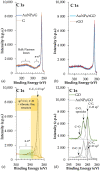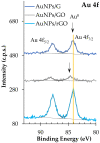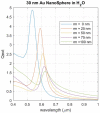Effect of Graphene vs. Reduced Graphene Oxide in Gold Nanoparticles for Optical Biosensors-A Comparative Study
- PMID: 35323433
- PMCID: PMC8946507
- DOI: 10.3390/bios12030163
Effect of Graphene vs. Reduced Graphene Oxide in Gold Nanoparticles for Optical Biosensors-A Comparative Study
Abstract
Aiming to develop a nanoparticle-based optical biosensor using gold nanoparticles (AuNPs) synthesized using green methods and supported by carbon-based nanomaterials, we studied the role of carbon derivatives in promoting AuNPs localized surface plasmon resonance (LSPR), as well as their morphology, dispersion, and stability. Carbon derivatives are expected to work as immobilization platforms for AuNPs, improving their analytical performance. Gold nanoparticles (AuNPs) were prepared using an eco-friendly approach in a single step by reduction of HAuCl4·3H2O using phytochemicals (from tea) which act as both reducing and capping agents. UV-Vis spectroscopy, transmission electron microscopy (TEM), zeta potential (ζ-potential), and X-ray photoelectron spectroscopy (XPS) were used to characterize the AuNPs and nanocomposites. The addition of reduced graphene oxide (rGO) resulted in greater dispersion of AuNPs on the rGO surface compared with carbon-based nanomaterials used as a support. Differences in morphology due to the nature of the carbon support were observed and are discussed here. AuNPs/rGO seem to be the most promising candidates for the development of LSPR biosensors among the three composites we studied (AuNPs/G, AuNPs/GO, and AuNPs/rGO). Simulations based on the Mie scattering theory have been used to outline the effect of the phytochemicals on LSPR, showing that when the presence of the residuals is limited to the formation of a thin capping layer, the quality of the plasmonic resonance is not affected. A further discussion of the application framework is presented.
Keywords: AuNPs; Mie theory; biosensors; metal–graphene hybrid; simulations.
Conflict of interest statement
The authors declare no conflict of interest.
Figures












Similar articles
-
Functionalized gold nanoparticles/reduced graphene oxide nanocomposites for ultrasensitive electrochemical sensing of mercury ions based on thymine-mercury-thymine structure.Biosens Bioelectron. 2016 May 15;79:320-6. doi: 10.1016/j.bios.2015.12.056. Epub 2015 Dec 19. Biosens Bioelectron. 2016. PMID: 26720921
-
Synthesis and characterization of gold nanoparticles and graphene oxide for the development of optical fiber biosensors.Appl Opt. 2022 Sep 10;61(26):7618-7624. doi: 10.1364/AO.468734. Appl Opt. 2022. PMID: 36256361
-
Layer-by-layer assembled gold nanoparticles/lower-generation (Gn≤3) polyamidoamine dendrimers-grafted reduced graphene oxide nanohybrids with 3D fractal architecture for fast, ultra-trace, and label-free electrochemical gene nanobiosensors.Biosens Bioelectron. 2018 Nov 30;120:55-63. doi: 10.1016/j.bios.2018.08.032. Epub 2018 Aug 16. Biosens Bioelectron. 2018. PMID: 30145435
-
Ag and Au nanoparticles/reduced graphene oxide composite materials: Synthesis and application in diagnostics and therapeutics.Adv Colloid Interface Sci. 2019 Sep;271:101991. doi: 10.1016/j.cis.2019.101991. Epub 2019 Jul 17. Adv Colloid Interface Sci. 2019. PMID: 31376639 Review.
-
Application of Gold Nanoparticle to Plasmonic Biosensors.Int J Mol Sci. 2018 Jul 11;19(7):2021. doi: 10.3390/ijms19072021. Int J Mol Sci. 2018. PMID: 29997363 Free PMC article. Review.
Cited by
-
Targeting oxidative damage in diabetic foot ulcers: integrative strategies involving antioxidant drugs and nanotechnologies.Burns Trauma. 2025 Mar 10;13:tkaf020. doi: 10.1093/burnst/tkaf020. eCollection 2025. Burns Trauma. 2025. PMID: 40718700 Free PMC article. Review.
-
Deposition of Graphene Oxide on an SPR Fiber Refractometer for Sensor Applications.Sensors (Basel). 2023 Apr 19;23(8):4098. doi: 10.3390/s23084098. Sensors (Basel). 2023. PMID: 37112439 Free PMC article.
-
Elucidating Sensitivity and Stability Relationship of Gold-Carbon Hybrid LSPR Sensors Using Principal Component Analysis.ACS Omega. 2022 Jul 27;7(31):27664-27673. doi: 10.1021/acsomega.2c03326. eCollection 2022 Aug 9. ACS Omega. 2022. PMID: 35967070 Free PMC article.
-
Breaking barriers in cancer diagnosis: unveiling the 4Ms of biosensors.RSC Adv. 2025 Mar 17;15(10):8019-8052. doi: 10.1039/d4ra08212e. eCollection 2025 Mar 6. RSC Adv. 2025. PMID: 40098694 Free PMC article. Review.
References
-
- IUPAC . Glossary for Chemists of Terms Used in Biotechnology. Blackwell Scientific Publications; Oxford, UK: 1997. Biosensor Definition; 148. - DOI
-
- Yaseen M., Humayun M., Khan A., Usman M., Ullah H., Tahir A.A., Ullah H. Preparation, Functionalization, Modification, and Applications of Nanostructured Gold: A Critical Review. Energies. 2021;14:1278. doi: 10.3390/en14051278. - DOI
-
- Špačková B., Wrobel P., Bocková M., Homola J. Optical Biosensors Based on Plasmonic Nanostructures: A Review. Proc. IEEE. 2016;104:2380–2408. doi: 10.1109/JPROC.2016.2624340. - DOI
MeSH terms
Substances
Grants and funding
LinkOut - more resources
Full Text Sources

